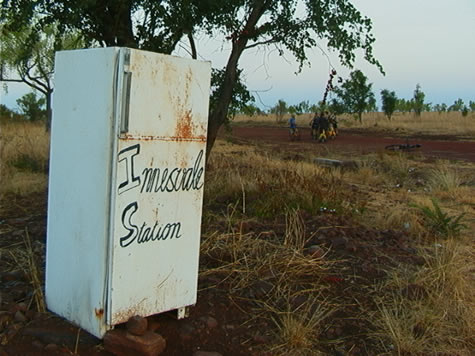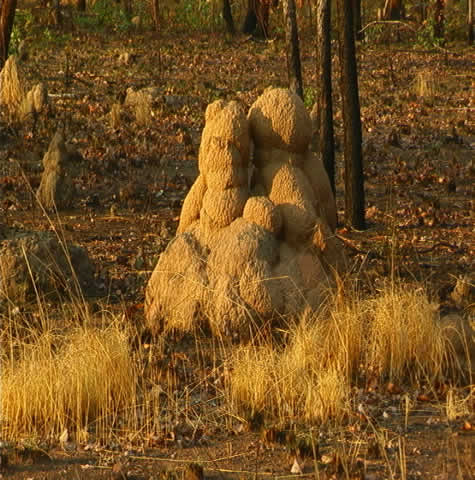THEME: Creepy Crawlies
SUBJECT: Environment
TOPIC: Termites
2001 October 11, Thursday. Innesvale Station.

While ecosystems and their inhabitants have come and gone, one feature of the landscape has been our constant companion since we left the beach at the Starcke eighty days ago. From big enough to climb upon for a 360 degree view, to dainty enough to be knocked over by a wayward cyclist (cheap imported rubbish, falling apart . . .); from the red of the Tanami, to the grey of the ranges; from lumpy and dumpy, to tall and fluted – they have been ever-present and infinitely fascinating.

In fact, the more we learn about termite mounds and their bite-size inhabitants, the more enraptured we become. More so perhaps than Verna Kruckow, our unimpeachable hostess back at Pinnacle Springs Station, who has to share her house with them. We haven’t yet tired of their presence, however, as they keep mostly to themselves, and we’re too busy dealing with blow flies. Here are some terrific facts you mightn’t know about the tincy little things which cover most of the Northern Territory:
*It is unusual for termites to be active in the daytime. This is because their soft bodies cannot prevent water loss enough to survive in the sun’s heat.
*Sometimes, geckos lay their eggs inside termite mounds.
*Golden-shouldered Parrots, Hooded Parrots and the extinct Paradise Parrot build their nests in the mounds, and feed on the seeds of native grasses.
*The fact that there are millions of termites has allowed lizards to become very abundant. More lizards eat termites than anything else.
*Soldier termites have armoured heads and large jaws ready to attack anything which threatens the colony.
*Tens of thousands, and sometimes millions of termites inhabit each nest. There are so many that of you weighed all of the termites in one area they would weigh more than all the kangaroos in the same area.
*All the members of a colony continually exchange food and saliva with one another. These substances have chemicals in them which communicate messages to the whole colony. Each termite colony has a distinctive odour.
*Somewhere in the termite nets is a queen ant, gigantic in comparison with the other termite workers who feed and tend to her needs.
*All of the three genera of ants are found in Australia.
*The Tanami Desert has eight hundred termite mounds per hectare.
*Termites collect water from the soil, tunnelling to depths of up to one hundred metres, to raise the humidity within the mounds. The galleries of most termite mounds have relative humidities of close to ninety-five per cent.
*The pregnant abdomen of the queen is swollen to many times the size of one of her attendants. She is the only mother amongst the thousands of termites and her sole job is to lay eggs, which she does continually.
*Termites eat cellulose – the hard part of plants, such as the trunks of trees and the hard spiky leaves of spinifex. Because hardly any other animal can eat this, termites have an abundant supply of food. They also eat animal dung.
*Ants are one of the most diverse genus of multi-celled organisms in the world, along with Acacia Trees, and Dung Beetles.
*There are often openings in the ground at the base of a spinifex clump. These are entrances to the termite nest, highways leading into an underground metropolis of ants, and are the reason termites are rarely seen around the mounds.
*Ants survive in Arid Australia at ground temperatures of over sixty-five degrees centigrade.
Suggested learning activities:
Try to find answers to as many of the following questions as you are able. Be creative – visit the school library, ask your teachers and parents, check the internet – you might even find some of the answers in this update . . .
How do termites differ from ants?
Who are the termites main predator?
How big can an ant grow?
How far does termite mound covered land extend in the Northern Territory and Queensland?
Where else in the world are termite mounds found?
What type of animal is a termite?
How many eggs can a queen ant lay and how long do they take to hatch?
What similarities does a termite colony have to a bee hive?
What adaptations have termites developed to cope with desiccation?
. . . and anything else you can think of.